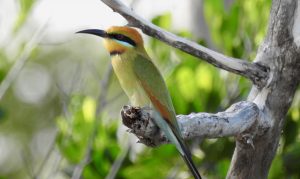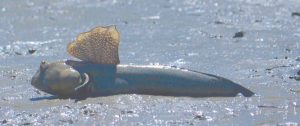Part of the “A Pioneering Cruise Line” Anthology of Stories
Mangroves: Forests Of The Intertidal Zone
By Tom Collis
Tom Collis, currently a resident of Cairns, has joined many of the Coral Expeditions cruise itineraries as a Guest Lecturer. Tom has spent much of his life in the north of Australia where he continually expands his knowledge as a naturalist with a strong interest in ornithology. His undergraduate training in applied science and education are evident in the way he enthusiastically presents his landscape and wildlife interpretations to guests. The following article by Tom describes some of the unique features of mangroves and their role as the home base for many interesting animal species. In a later article, Tom describes part of the wide range of bird species guests may see during Coral Expeditions cruises in both temperate and tropical waters.

The dense and ecologically important red
mangrove habitat (Rhizophora mangle) of the hunter River, Porosus Creek.
Most of us think of mangroves as being muddy, smelly, hot,humid, mosquito- infested swamps. Unlike othercoastal habitats, such as coral reefs, mangroves don’t usually rate highly as places to visit. Australia is well represented with mangroves, having the third largest mangrove area in the world. The majority of Australia’s mangroves are distributed along the coast of Northern Australia, areas regularly frequented by Coral Expeditions. On our cruises, guests have easy access to mangroves from the comfort of the Explorer/Xplorer tenders and most people are quite surprised at just how beautiful and interesting, these forests of the intertidal zone are.
To the untrained eye, all mangrove trees look the same, and indeed they have all evolved in an environment that has resulted in similar looking plants. The domination of the foreshore by one or two species adds to the impression that all mangrove plants are the same. However, in Australia, there are 42 different known species plus many more orchids, ferns, lichen and mistletoe that grow on these mangroves. When mangroves are viewed from a boat, the most commonly seen species is the stilt rooted mangrove, which dominates the outermost region of the intertidal zone. Further back from these frontline mangroves many other species thrive too. Their growth is determined by very specific environmental conditions such as salinity levels.
All the mangrove plants had their origins on land and millions of years ago several land plants were successful in colonising the intertidal zone. To live in this quite variable environment mangrove plants adapted to cope with excess salt, constant inundation and waterlogged soils. Some mangroves exclude the uptake of salt via a fine filtration system in the roots – they more or less desalinate the saltwater before taking it up into the plant. Other mangroves exude excess salt via specialised glands on the leaves. Several mangroves use both methods and additional ways of getting rid of salty material, such as by shedding dead leaves and bark. One species, the cedar mangrove is deciduous, and this may be a strategy to help rid the plant of salt by dropping all its leaves annually.

Mangroves line the foot of a sandstone clliff face in the Kimberley.
The tangled roots of mangroves are easily observed at low tide because a large part of the root system is above the surface of the mud. The extensive root systems support the plants in the soft mud, holding the sediments together in the process. Some of the root forms are unique to mangroves and botanists recognise five different types with descriptive names such as stilt, knee, snorkel, aerial and buttress roots. The extensive grey mangrove has a system of snorkel roots that extend many metres from the canopy of the plant. The aptly named snorkel roots (or pneumatophores) assist with the uptake of air in oxygen poor, saturated soils.
 Mangrove trees produce flowers and rely on birds, bats and insects for pollination. Some species such as the rib-fruited mangrove have clever ways of distributing pollen. When honeyeaters probe for nectar, a trigger mechanism in the flower releases pollen over the bird’s head, ready for pollination of another flower. Some mangrove seeds float, so they are easily dispersed, such as the large, light seeds of the cedar mangrove and the unusual keeled-pod mangrove. Other mangroves use a process botanists call vivapary where the seeds germinate while still attached to the parent plant. These new propagules can stay on the parent plant for several years before being released. When they fall off the parent plant, they can grow underneath or float off with the tides to grow in a new location.
Mangrove trees produce flowers and rely on birds, bats and insects for pollination. Some species such as the rib-fruited mangrove have clever ways of distributing pollen. When honeyeaters probe for nectar, a trigger mechanism in the flower releases pollen over the bird’s head, ready for pollination of another flower. Some mangrove seeds float, so they are easily dispersed, such as the large, light seeds of the cedar mangrove and the unusual keeled-pod mangrove. Other mangroves use a process botanists call vivapary where the seeds germinate while still attached to the parent plant. These new propagules can stay on the parent plant for several years before being released. When they fall off the parent plant, they can grow underneath or float off with the tides to grow in a new location.

Rainbow bee-eater. Image: David Keech
Along the rocky coastline of the Kimberley, mangroves proliferate in the numerous sheltered bays with two of Australia’s most extensive stands of mangrove located in the St George Basin at the mouth of the Prince Regent River. These huge mangrove forests cover an area of 140 square kilometres, equivalent to about two and half times the area of Sydney Harbour.
An interesting mangrove in the Kimberley is the kapok mangrove, a relative of the iconic boab tree. It is not common in other areas of Australia, but in the Kimberley, it is often a dominant species and is particularly prevalent in the estuaries near Raft Point. The timber from this mangrove is very light and straight, and it is most likely the mangrove species used by Worrorra Aboriginal people to make wooden rafts. Early mariners observed Worrorra people paddling these double-layered rafts out to the offshore islands from Raft Point.
It is fascinating to observe the huge tidal range in the Kimberley, up to 11 metres in some areas, particularly in the mangroves. Mangrove species such as the club mangrove don’t grow much higher than a metre, and in the large tidal range, they are entirely submerged for well over 12 hours every day. This is quite remarkable for plants that produce flowers pollinated by insects!! During the high spring tides, the Coral Expeditions tenders can access the very upper reaches of the many creeks in the Kimberley. Mangroves flooded at high tide may have a few birds in their foliage above the water but below it is a very different story. Sharks and fish take the opportunity to hunt in the otherwise inaccessible areas of the mangroves. Diamond-scaled mullet seek out the shallower areas to escape predation by barramundi and mangrove jack.

Flame Fiddler crab. Image: Tom Collis.
As the tide drops huge mud banks become exposed, and bright orange-red flame fiddler crabs emerge warily from their burrows. The male fiddler crabs have one enormous claw that is used to attract female crabs and to fend off other male crabs. They also have a much smaller claw to feed on the algae growing on the mud surface.

Mudskipper with dorsal fin erected. image: Tom Collis
Another interesting animal that is regularly seen on the low tides is the mudskipper, a fish that has adapted to live out of water for long periods. Mudskippers use their pectoral fins to ‘walk’ or ‘skip’ on the mud flats. They have specialised gills that don’t collapse when the fish is out of water, and they can absorb oxygen through their skin and the inside of their mouth. Mudskippers and fiddler crabs are very wary of the numerous predators looking for them at low tide. Bird species such as the chestnut rail and kingfishers feed on the huge numbers of fiddler crabs on the mud banks at low tide while the striated and great-billed heron stalk and ambush mudskippers.
Many other animals call the mangroves home. Some are commonly seen such as the Indo Pacific or estuarine crocodile, the top predator of the mangroves. Several species of flying fox or fruit bats camp in the mangroves keeping a watchful eye out for the predatory white-bellied sea eagle. Many smaller animals are known to exist in the mangroves but are rarely seen, such as the fishing bat Myotis. Lucky people may get to see the snub-finned dolphin, a species only described by scientists in 2003. These little dolphins have an astonishing method of catching fish. They hunt together and squirt water forward from their mouths for about two metres confusing small fish and sending them in all directions, often towards the dolphin’s waiting jaws. They can also flick small fish with their tail towards their own mouth.
The coxswains of our expedition vessels are very skilled at navigating the mangroves. A pre-dawn cruise is an unforgettable experience as we venture deep into the mangroves, stop and turn off the engines. Occasionally the silence is broken by loud pops and clicks made by the pistol shrimp, a rarely seen crustacean that lives in the wetter mud. As the day breaks the mangrove birds begin the dawn chorus with the first call often being the plaintive double whistle of the mangrove robin. A visit to the mangroves at night is another exciting adventure, particularly for those who want to see estuarine crocodiles. When viewed up close with a spotlight it is common to see them snapping and feeding on mud crabs and fish on the muddy banks. Cruising into the mangroves with Coral Expeditions is an experience not to be missed.






